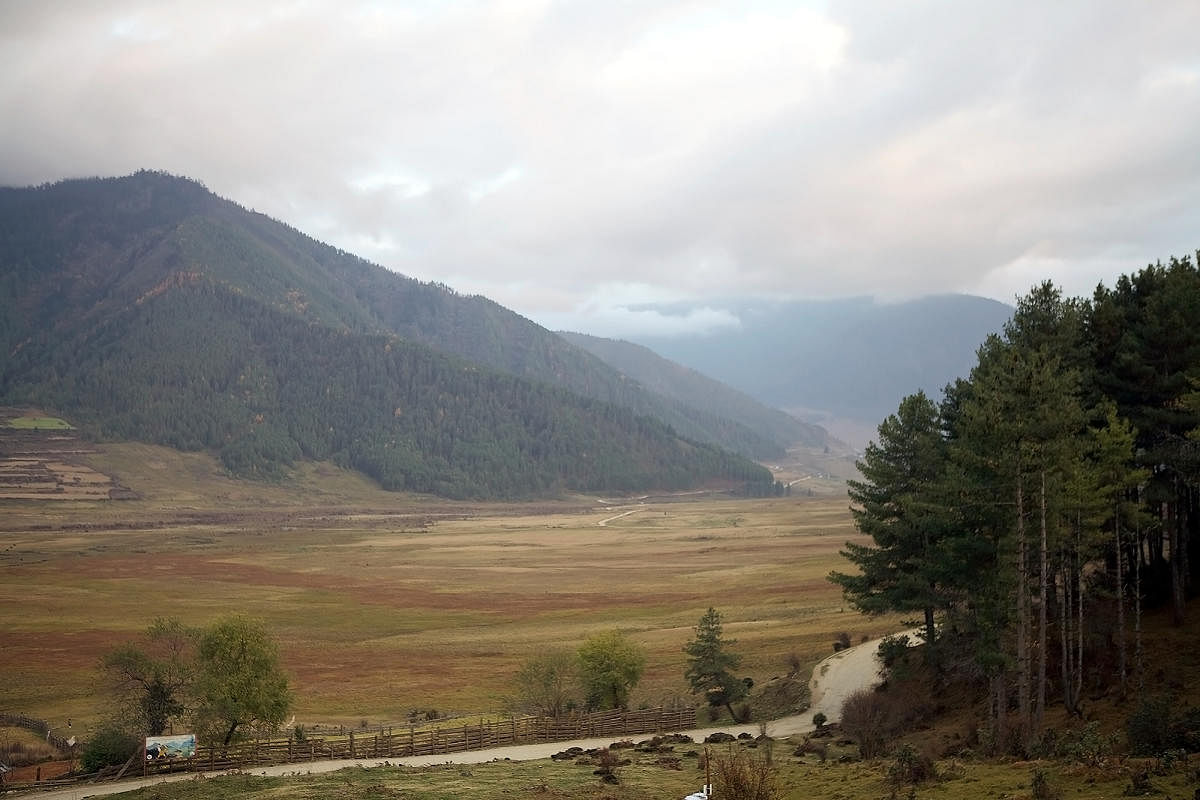
We couldn’t have picked a better season to visit Bhutan. With clear and sunny skies during the day and the right amount of nip in the air in the evenings, we found the weather just perfect in the month of November. What’s more, this is also the time that you can witness the annual migration of the black-necked cranes from Tibet to their winter habitat in the Phobjikha Valley of Bhutan.
We set out on the 78 km drive from the town of Punakha to the higher altitudes and alpine regions of the Phobjika Valley. You know you have reached the higher reaches when you encounter the majestic yaks en route. And suddenly after the twists and turns, you encounter the vast breathtaking expanse of the Phobjika Valley. The Gangtey Valley, as it is also called after the ancient Gangteng/ Gangtey Monastery, is at an elevation of 3,000 m on the west side of the Black mountain range of Bhutan.
Red alert
It is in these wetlands that the black-necked cranes (Grus nigricollis) come to nest towards the end of October, and remain here till early March, before returning to the summer breeding grounds in Tibet. It is astonishing to learn that these cranes have been making this journey for centuries. The black-necked crane was one of the last species of cranes to be discovered by Russian naturalist Nikolay M Przhevalsky in 1876. However, all is not well as ornithologists and naturalists consider the black-necked crane as ‘vulnerable’ to extinction and they are in the red list of threatened species by the International Union of Conservation of Nature. The bird is legally protected in Bhutan and any offense towards it is treated as a felony of the fourth degree under the Penal Code of Bhutan. The Phobjikha Valley has been declared as a Ramsar site or a wetland designated to be of international importance under the Ramsar convention that was signed in Iran.
Our young guide Tshering Dorji took us first to the information centre of the Royal Society for Protection of Nature (RSPN). RSPN is Bhutan’s first and only non-governmental organisation that promotes environmental education, sustainable livelihoods and conservation.
At the information centre, we were shown a short and informative documentary about the black crane and the work that RSPN does to prevent the cranes from falling prey to predators like dogs and leopards. RSPN is also working with local farmers so that there is a fine balance between anthropogenic activities that do not interfere with the habitat of the cranes. They have formed partnerships with local village leaders that encourage farmers to grow their crops organically so that there is no danger for the cranes when they look for food during their stay in the winter months in the valley. The farmers themselves believe that the presence of cranes would ensure a healthy crop.
Symbols of peace
The Bhutanese lovingly call these long-distance visitors ‘Thrung Trung Karmo’ and have great reverence for the ‘heavenly birds’ or Lhab Bja. The cranes are considered an embodiment of the 6th Dalai Lama and hence are a symbol of peace, love, beauty and, prosperity. It forms a part of Bhutanese folklore, music, and dance. You will also find them painted on the walls of homes and monasteries.
Physically, the cranes are about four feet tall with a bare red crown. The head, neck, and flight feathers are black and the body is ash grey to almost white underneath. Juveniles can be identified by the yellow-brown feathers on the crown. Locals say that when the cranes arrive in the valley, they make their way first towards the ancient Gangtey Monastery, circumambulating it three times before landing on the wetland marshes of Phobjika Valley. And they do the same before their journey back to Tibet. The inhabitants of Gangtey Valley celebrate the arrival of cranes by holding an annual black crane festival in November, a major tourist attraction.
After watching the film, it was time to watch the graceful birds themselves through RSPN’s high-power telescope. One, two, three, four and we excitedly counted up to 62. More would be expected with each coming day. While these were at a distance, the RSPN information centre had an injured crane in their care. Named Karma, this juvenile black neck crane was found wounded at the neck, perhaps by a feral dog in the lower valley of Phobjikha on January 6, 2016. It was nursed back but is still in rehabilitation and the RSPN is mobilising funds for a rehabilitation centre for future cranes like Karma who may require care.
After a quick coffee and some mandatory pictures, we made our way to the Gangtey Monastery that is so revered even by the black cranes. The Gangtey Gonpa or Gangteng Monastery is an important monastery of Nyingmapa School of Buddhism.
The Nyingma (literally means ancient) tradition is the oldest of the four major schools of Tibetan Buddhism and it was developed in the eighth century to translate Buddhist scriptures from Sanskrit into Old Tibetan. It is the main seat of the Pema Lingpa tradition, who was a Bhutanese saint.
After a visit to the monastery, we soaked in the ambience one last time before heading out to Punakha.